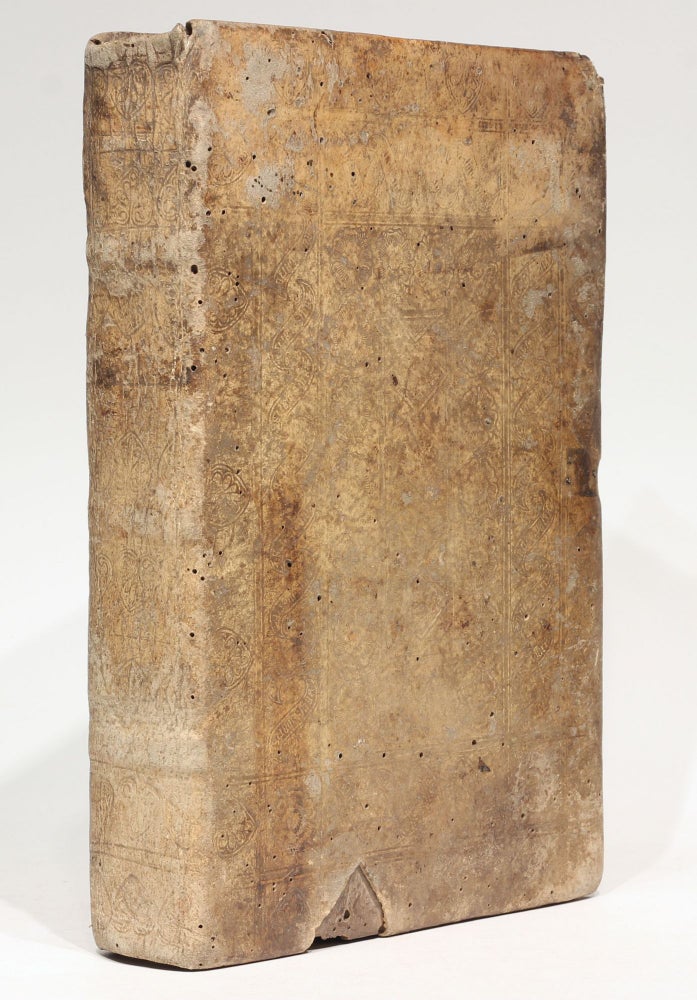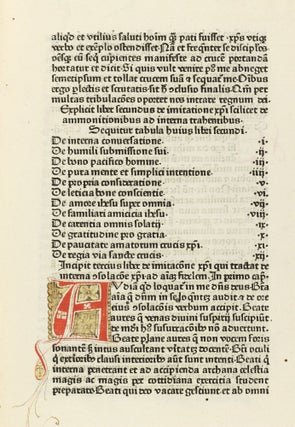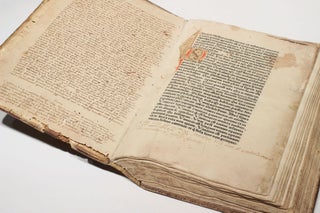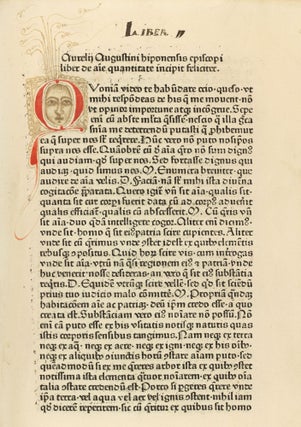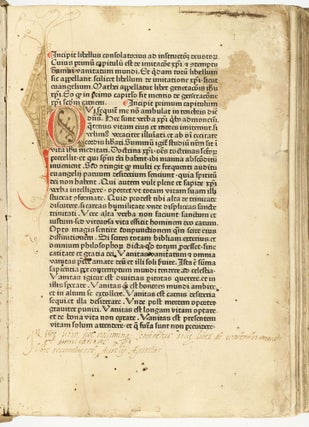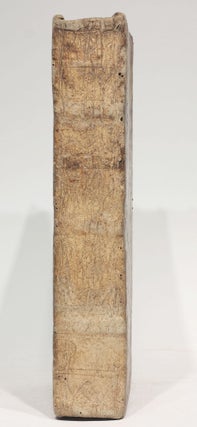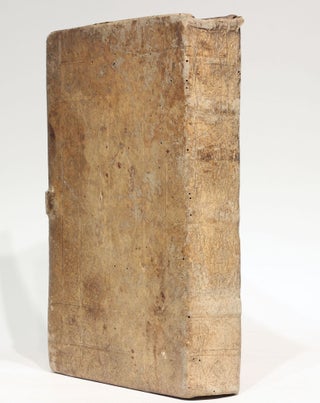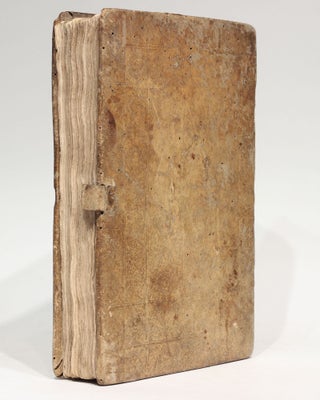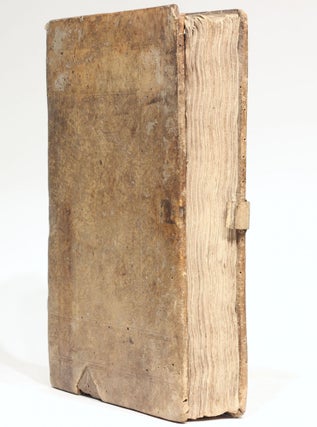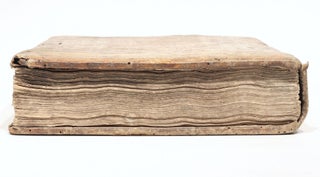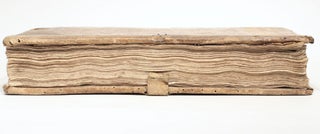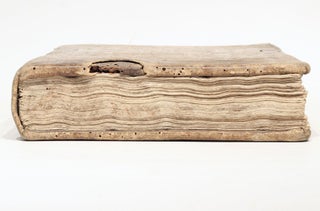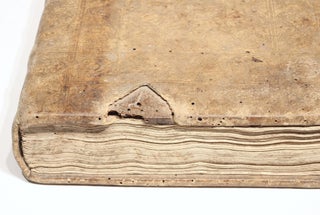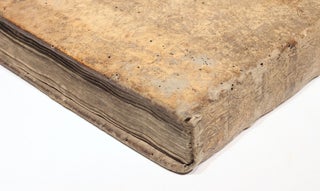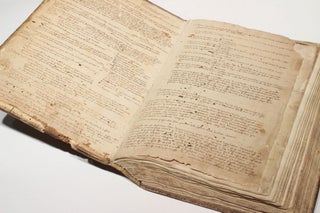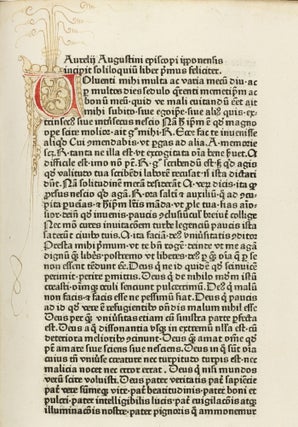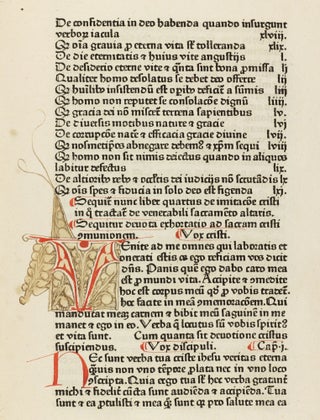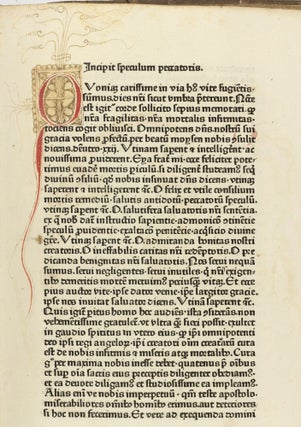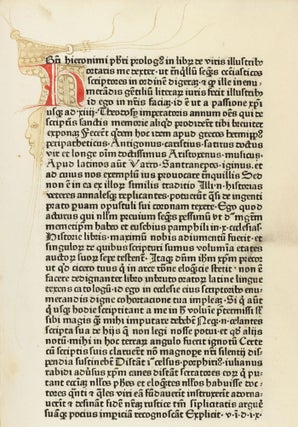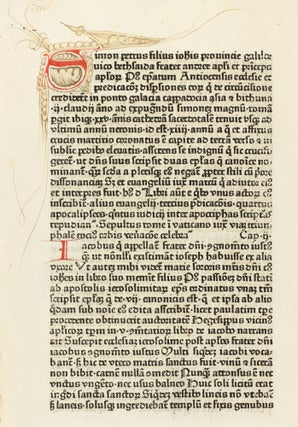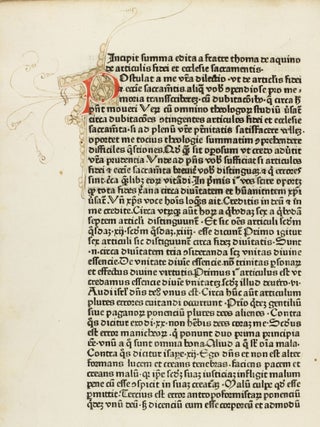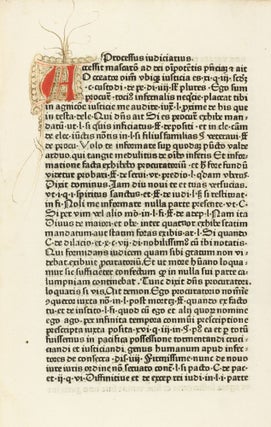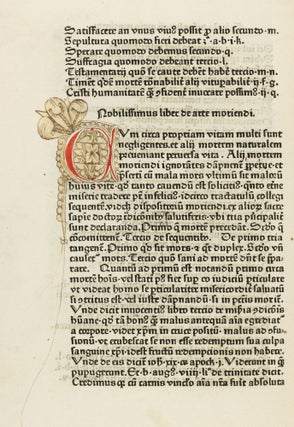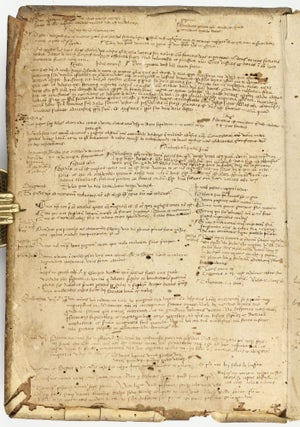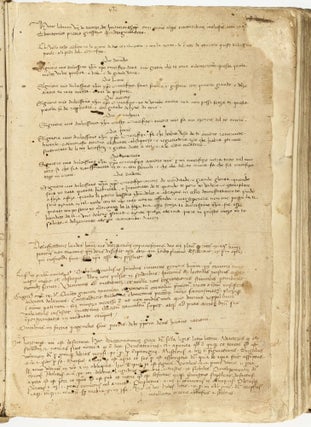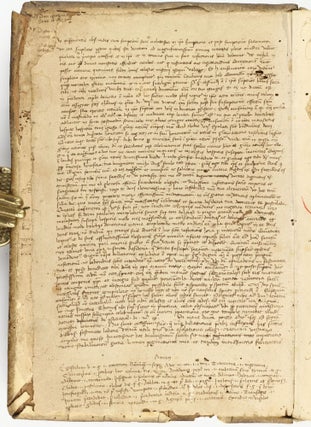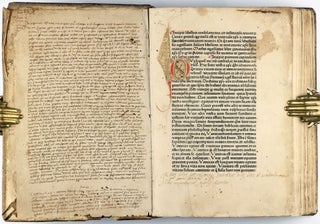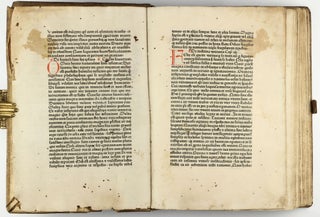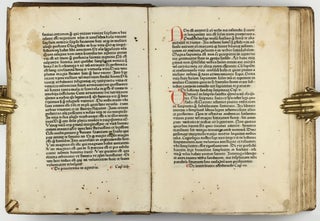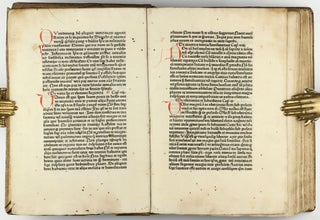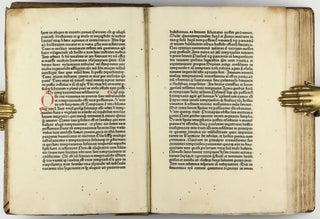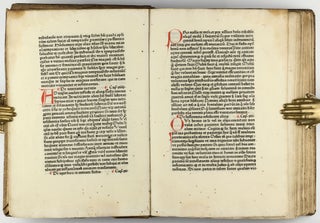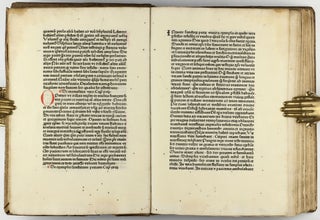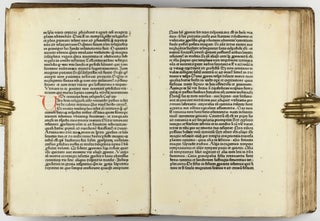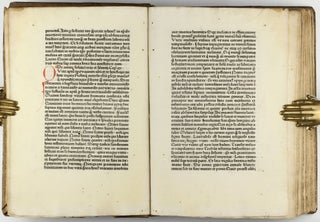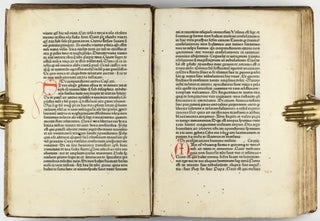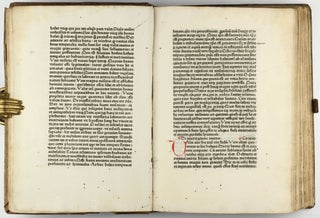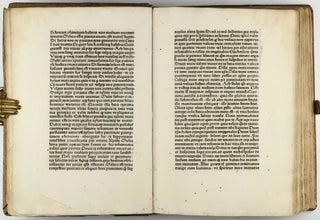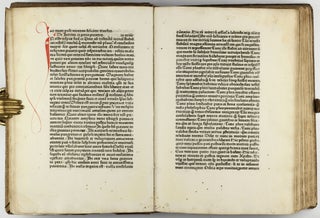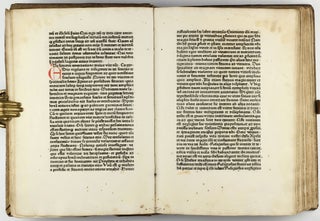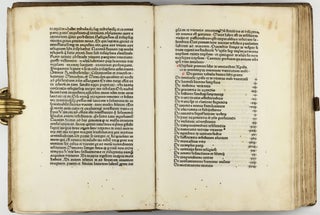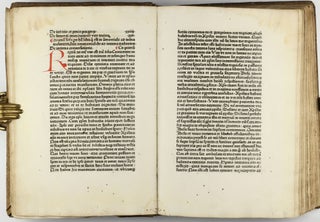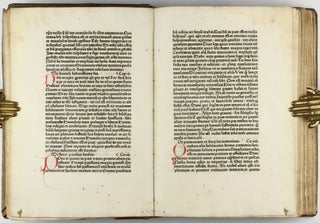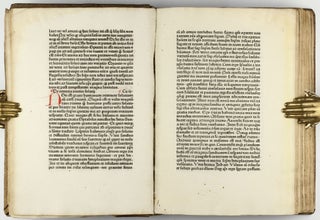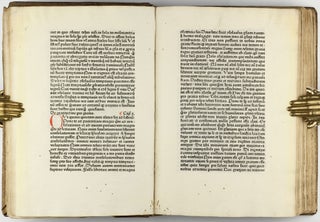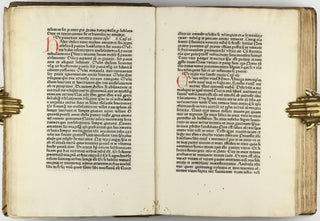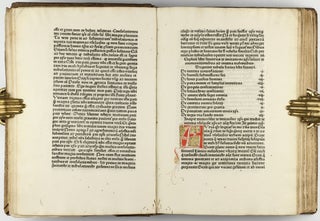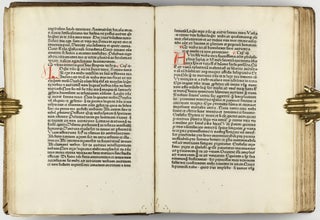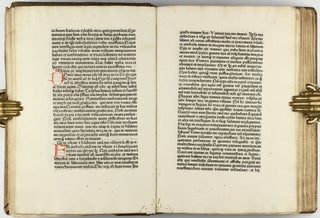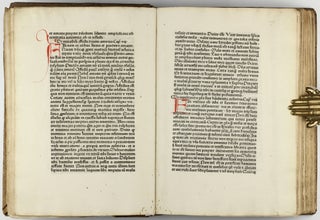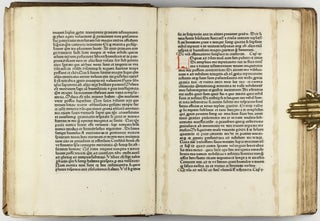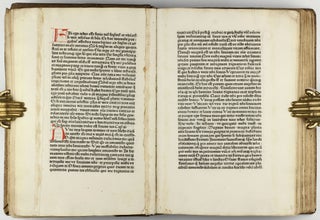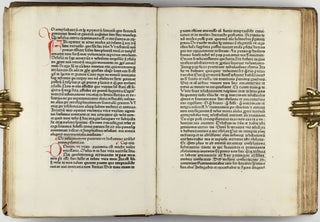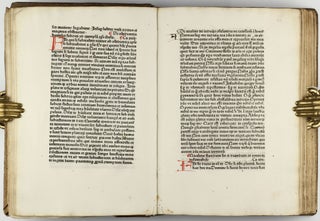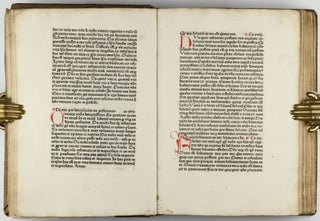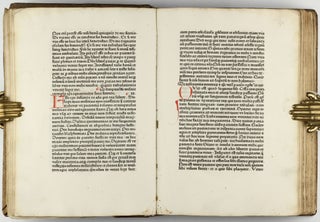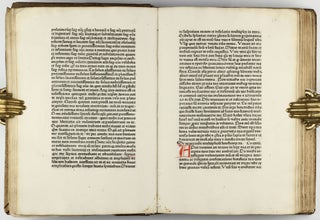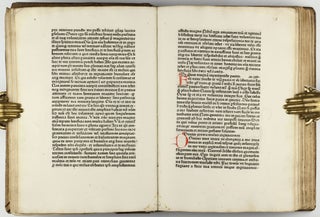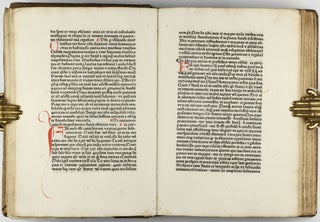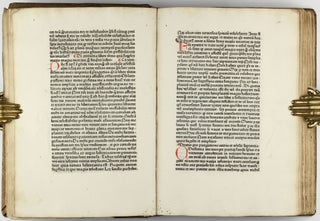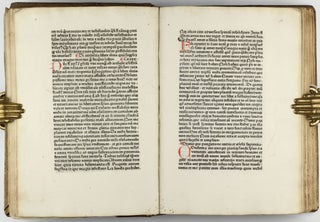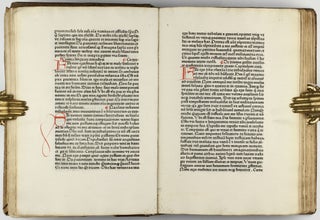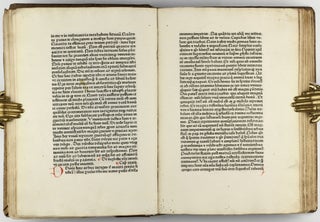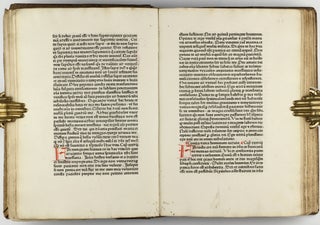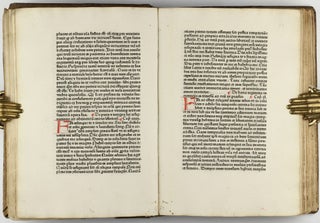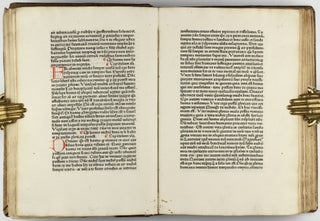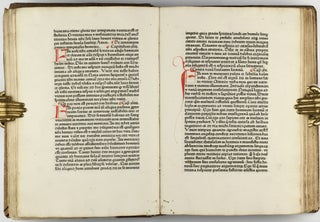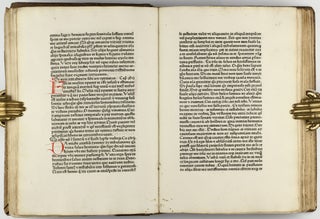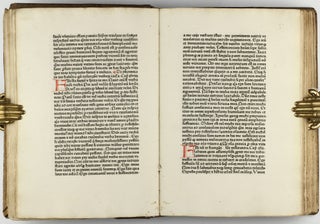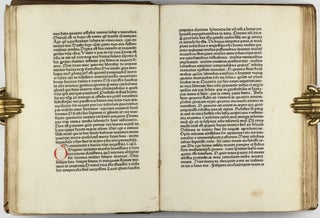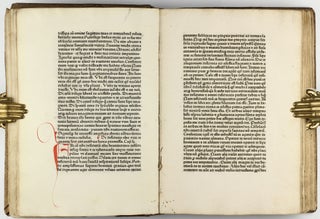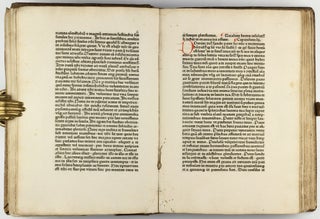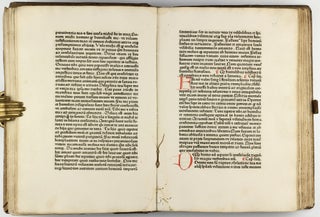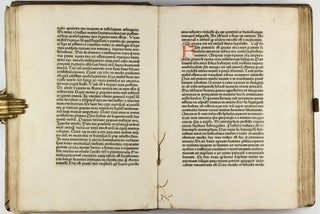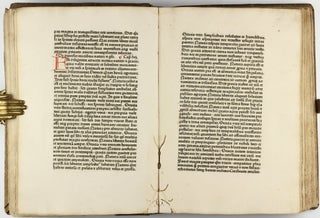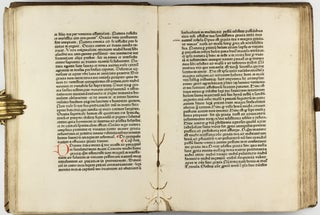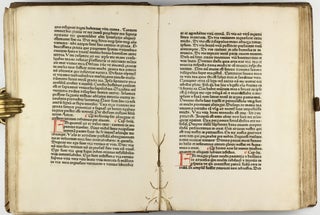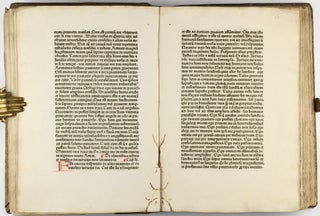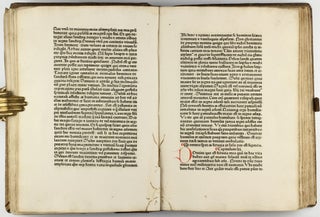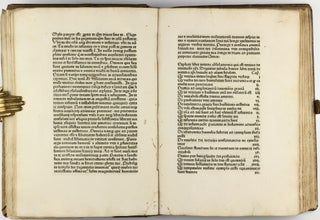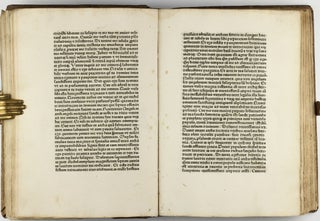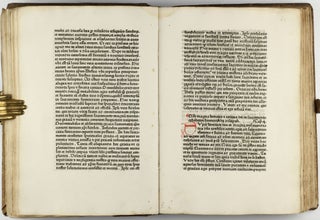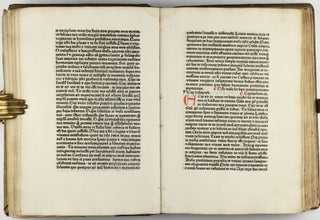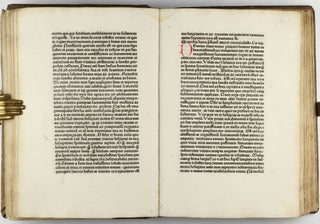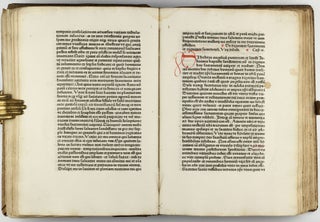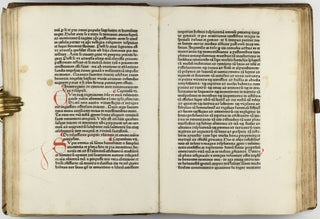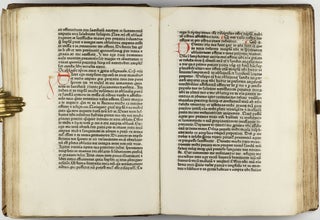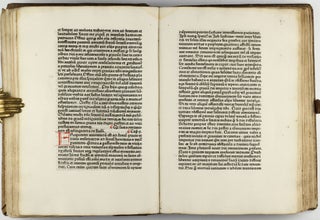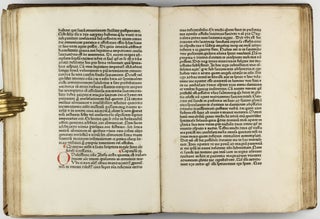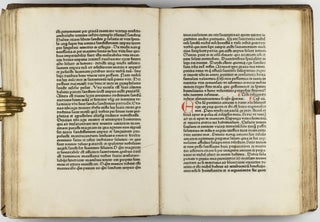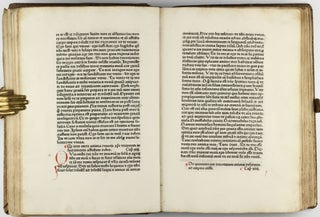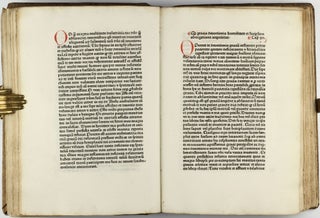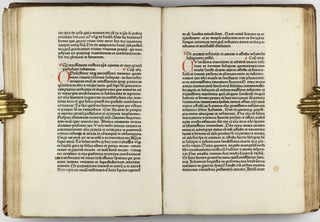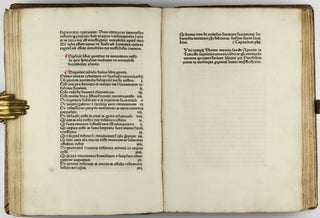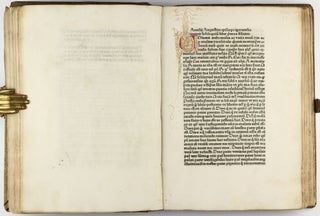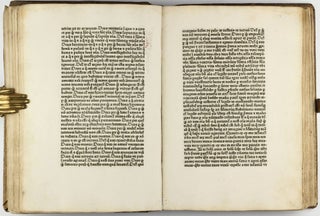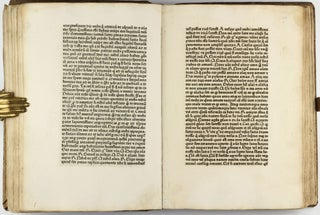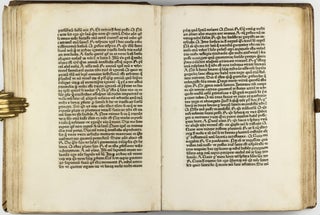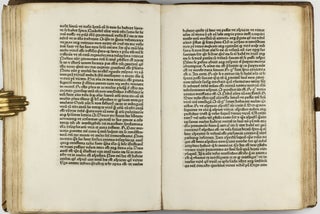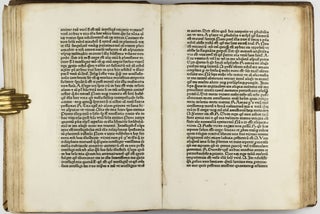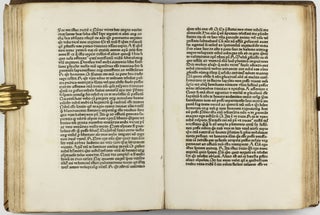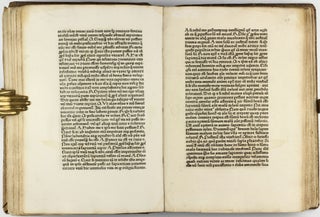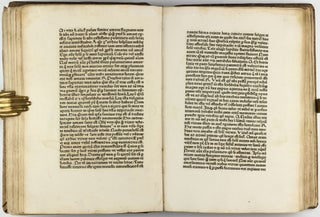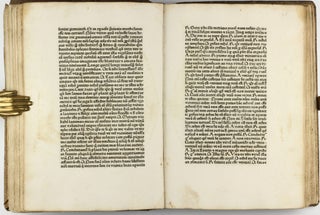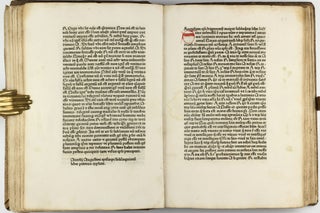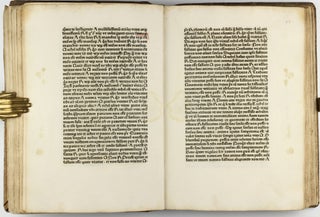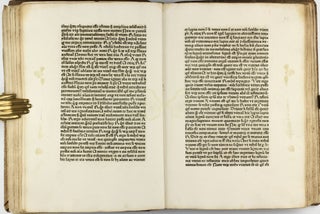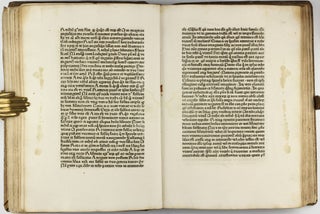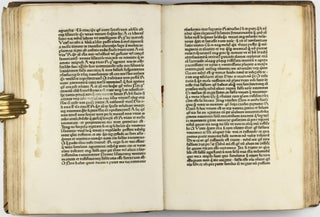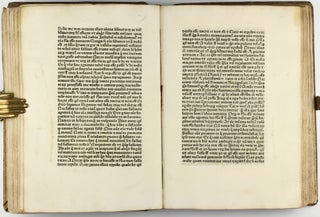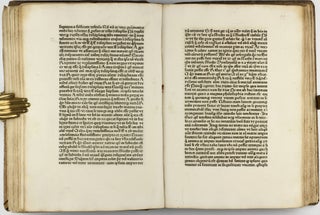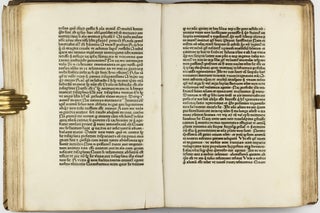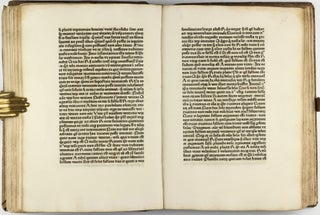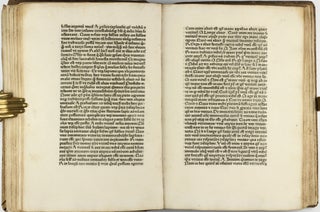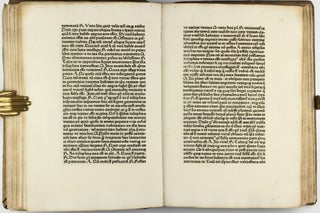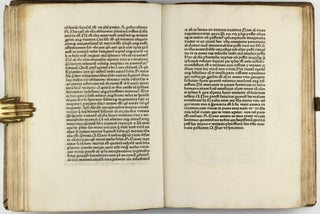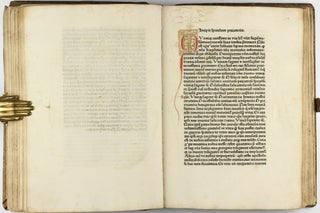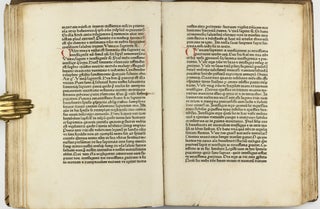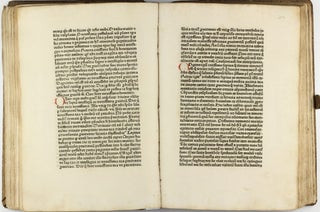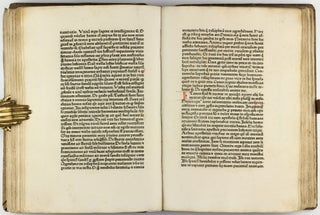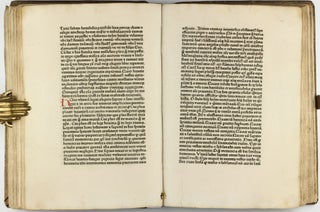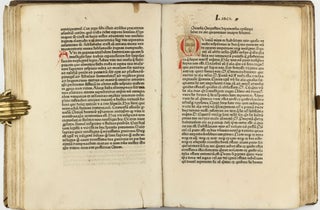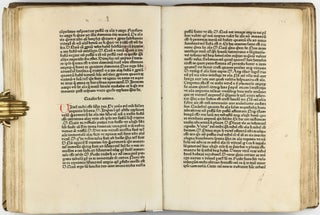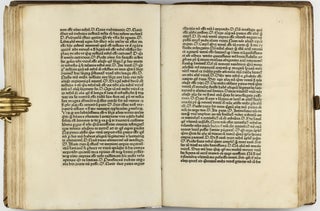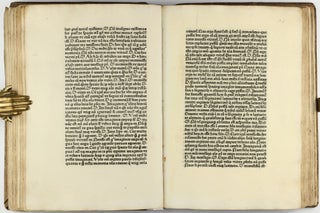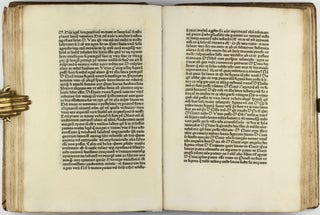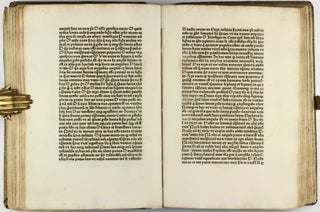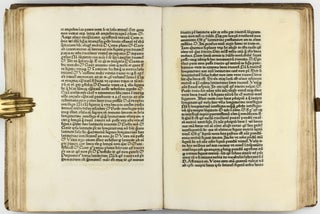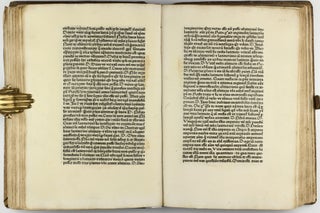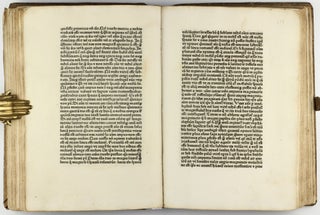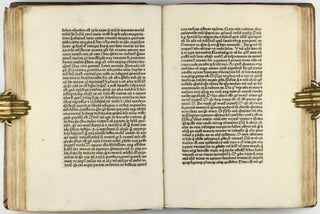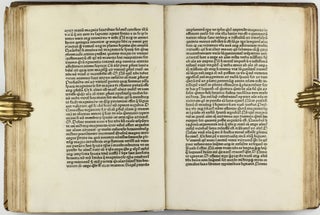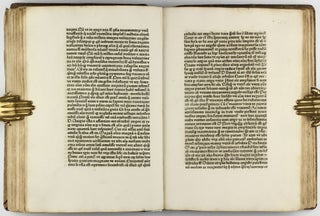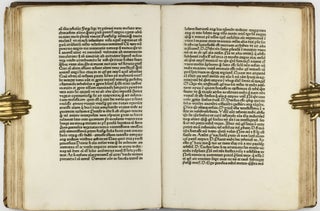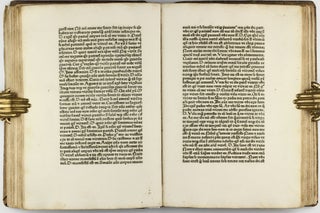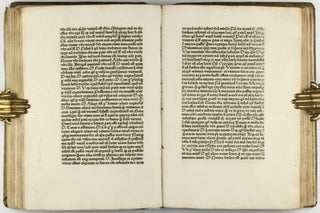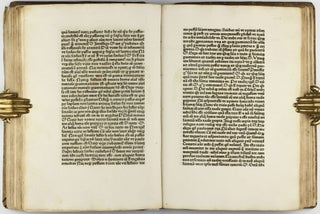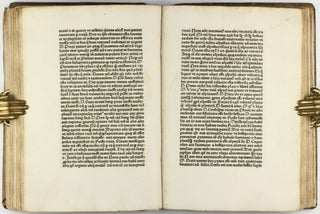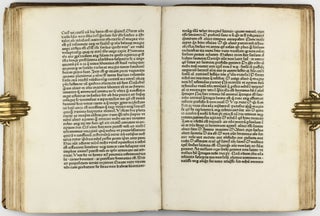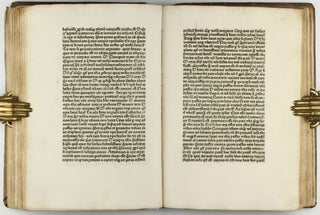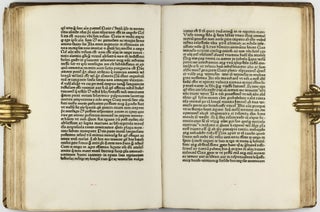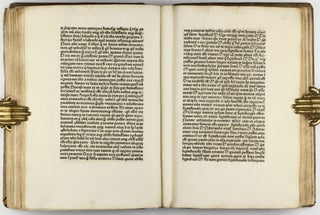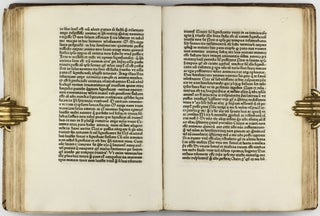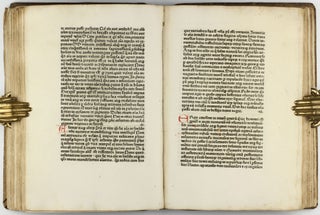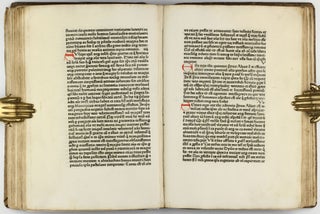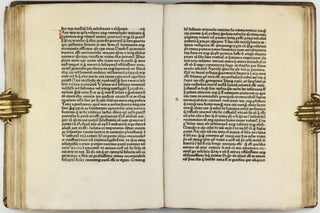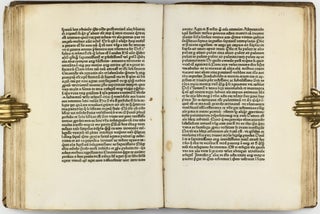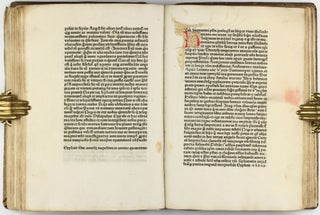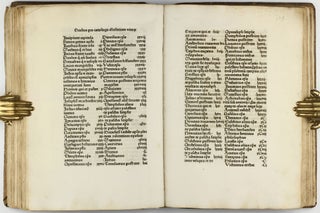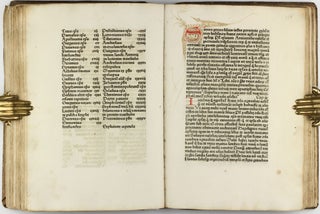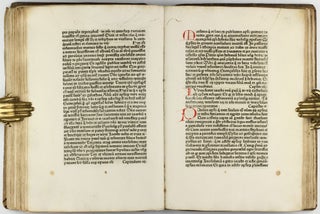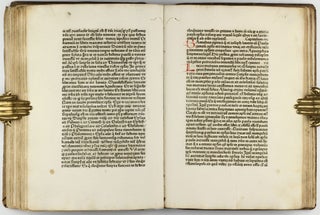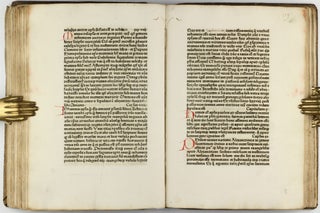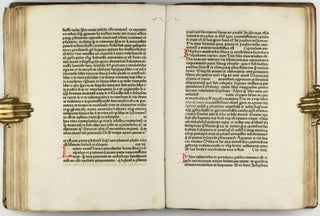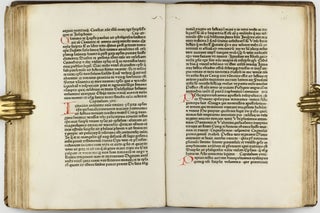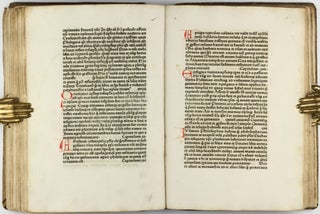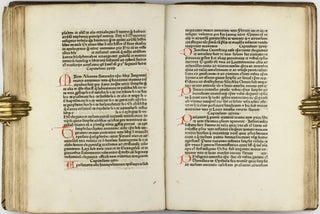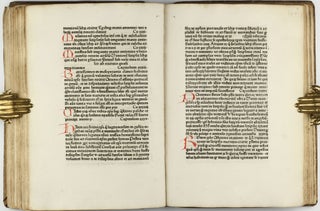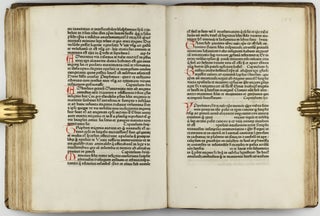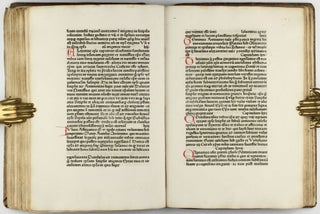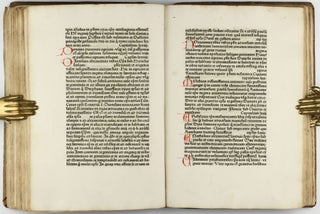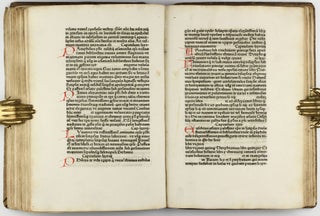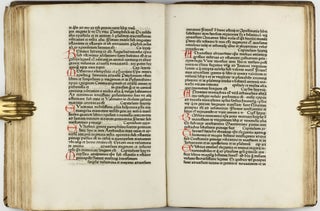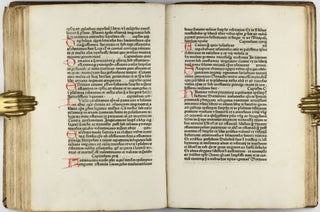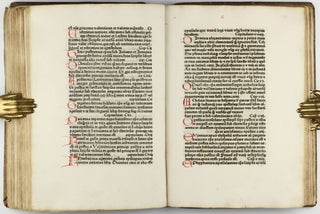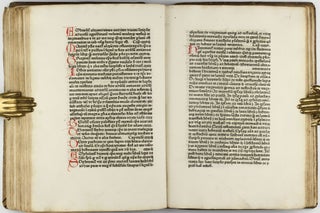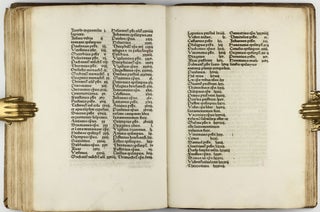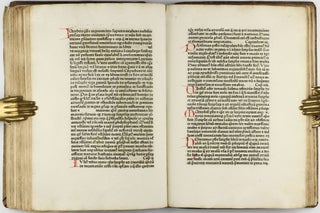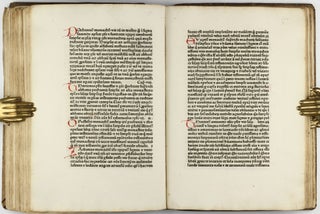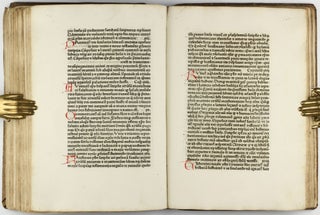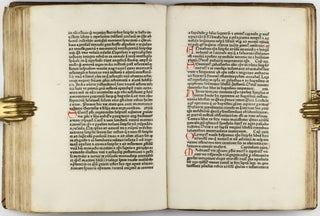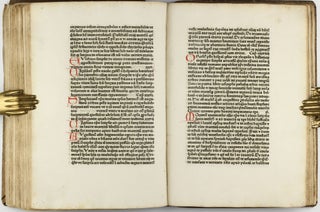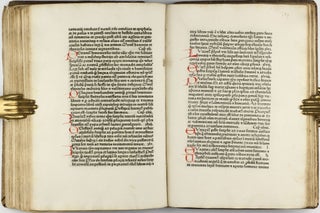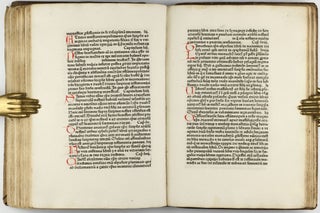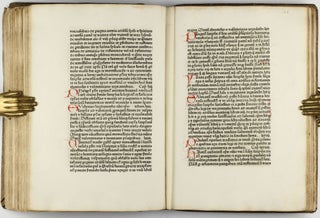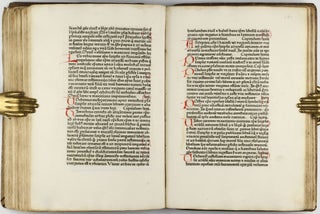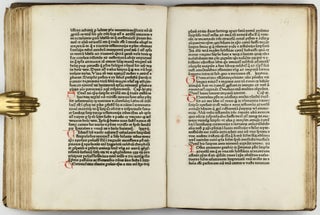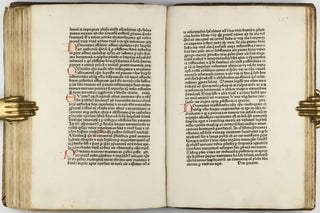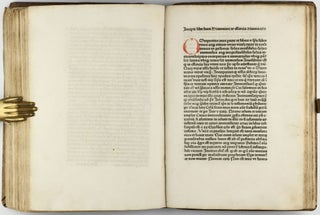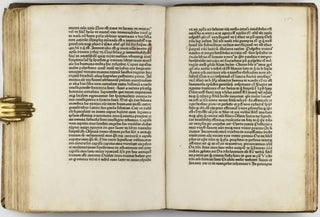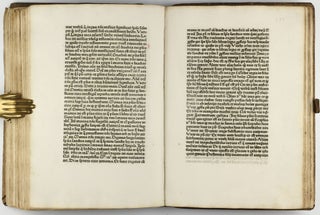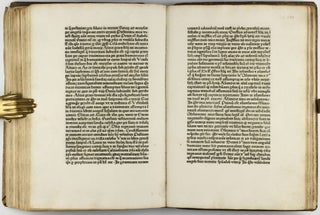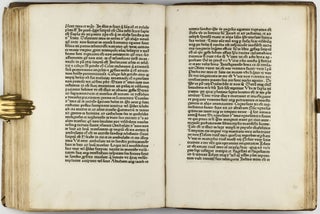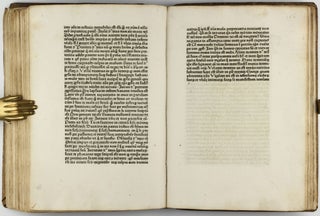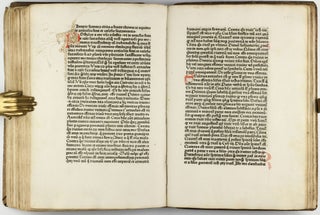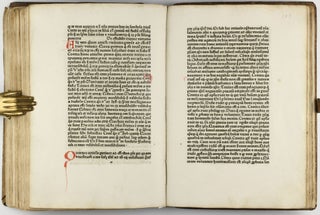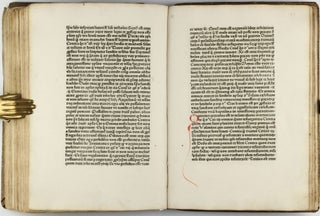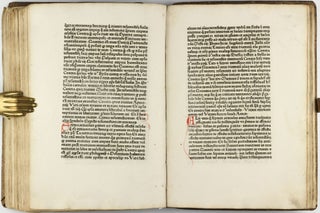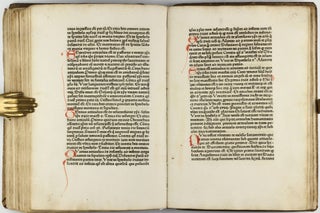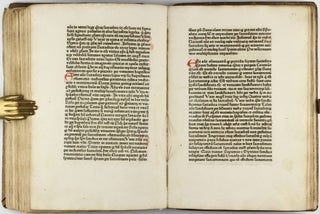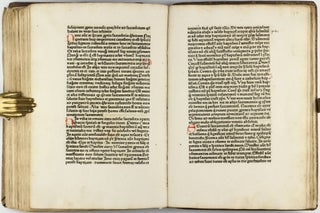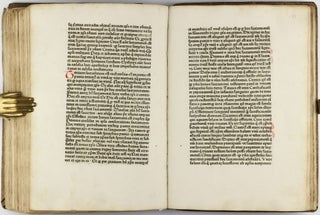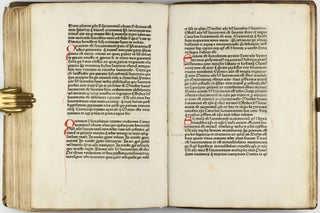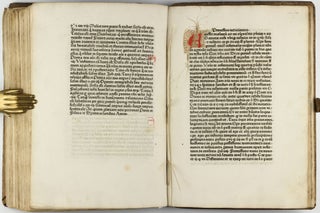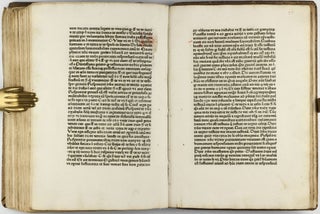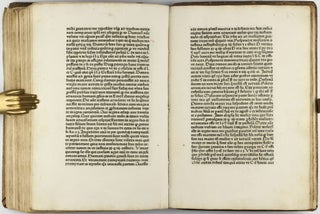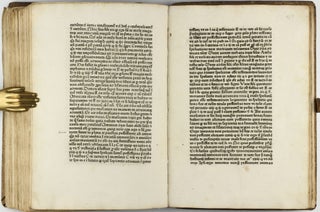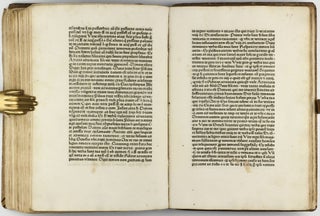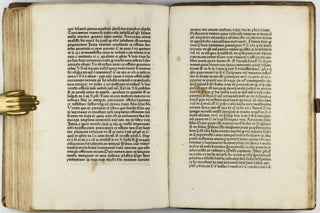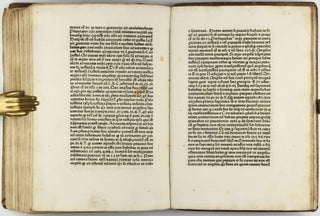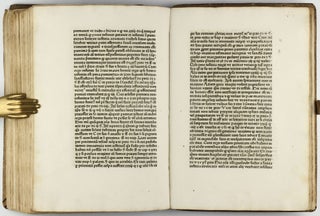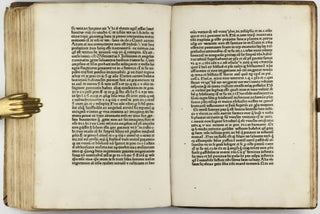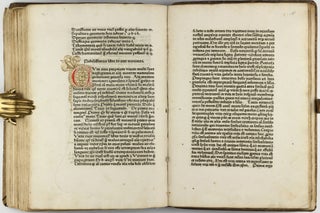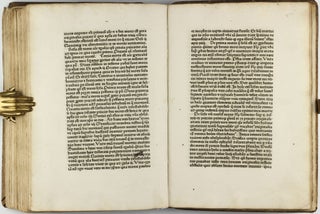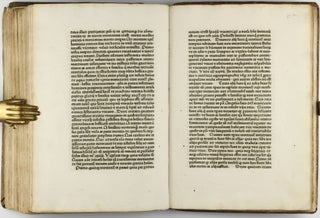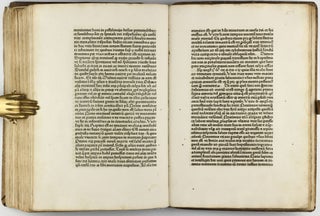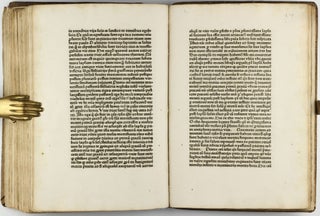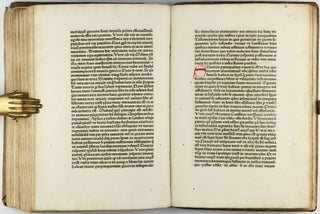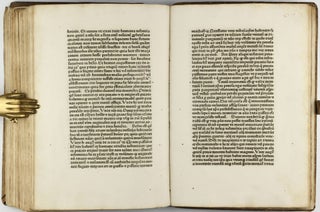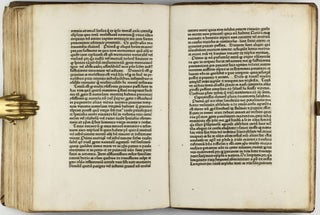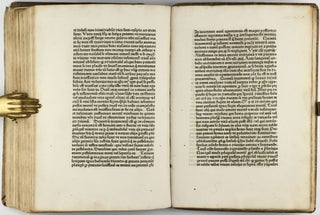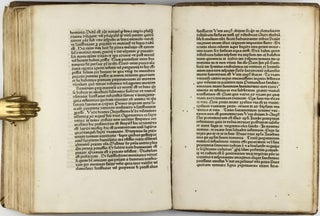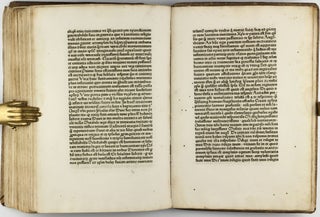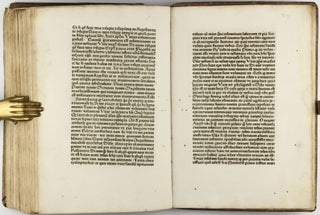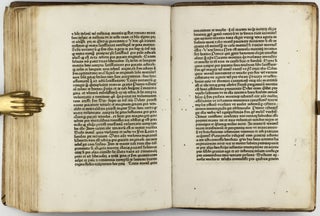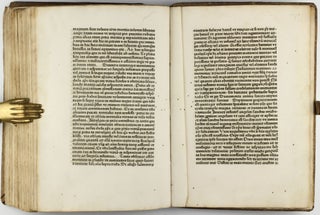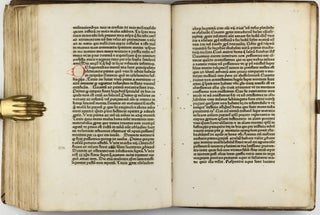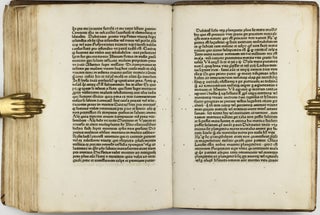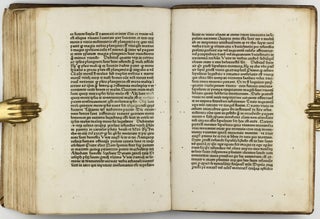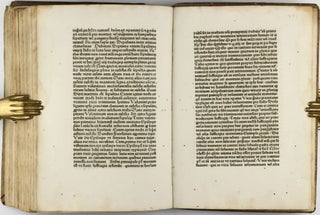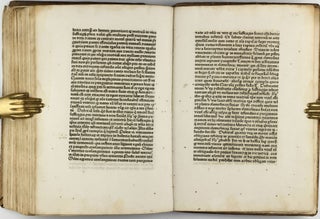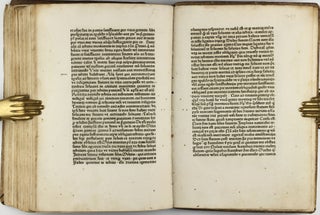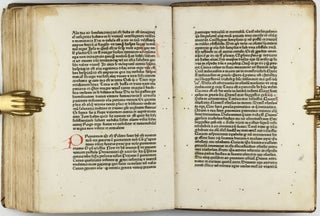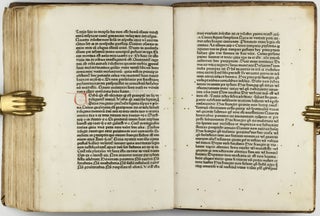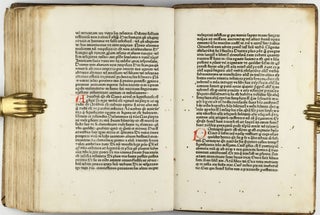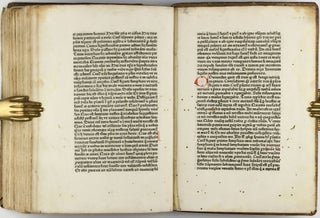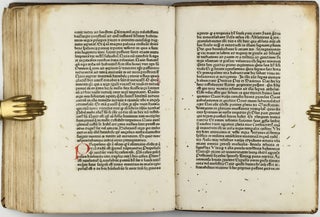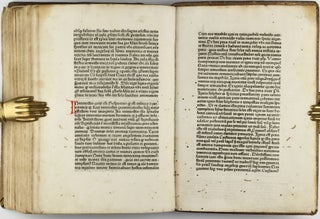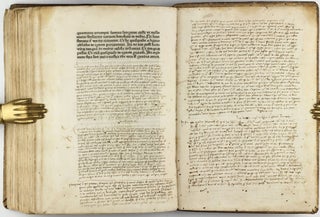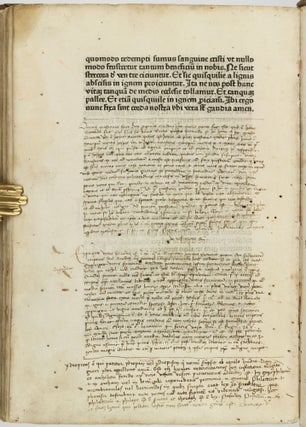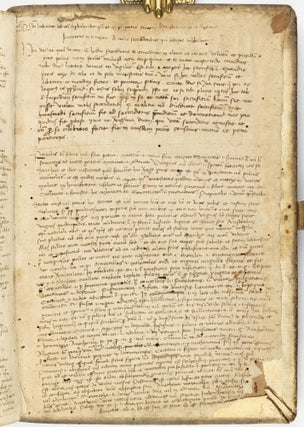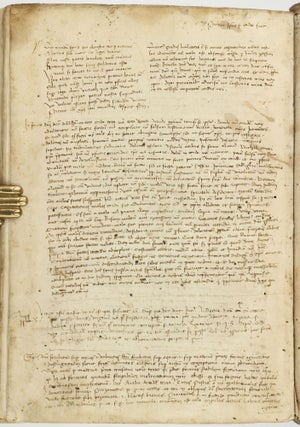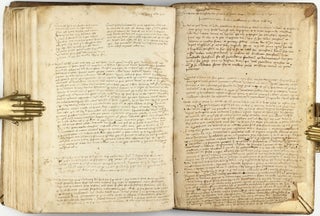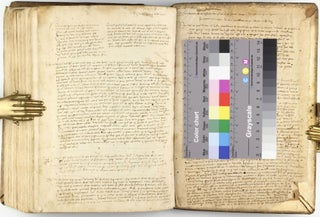Sammelband with 8 early Zainer printings including the editio princeps of Imitatio Christi
Imitatio Christi.
Augsburg: Günther Zainer, 1470.
1st Edition. Hardcover. Very Good. Item #003574
Augsburg: Günther Zainer, not after 1470. 76 unnumbered leaves. Collation: [a-g10 h6]. Bound with 8 other theological tracts printed by Zainer, 1472-1473, in identical format and layout. Foliation added in contemporary manuscript. 35 lines, gothic type, large, 3 to 6 line, opening initial to each work painted in red, light- and dark-brown (including 3 depicting anthropomorphic faces); 2 to 5 line red and light-brown painted paragraph initials, sheet 30 (corresponding to [c10]) shorter at fore-margin due to a typographical error and editorially integrated. All leaves uncut preserving the deckle edges. Folio (306 x 214 mm). Bound in its first, unrestored, German contemporary (gothic) blind-stamped pigskin over wooden boards from the Augsburg workshop of the so-called Wundervogel (or Fuchsvogel Meister I)*, with traces of a clasp on the upper board, probably in brass (small loss of leather at the lower edge of the upper board, minor rubbing and wear of extremities, corners scuffed with the wood showing, scattered small wormholes). The printed paper is generally bright and crisp, with minor occasional yellowish toning, marginal dust- and finger soling, and a few sporadic and light stains. Larger wormtracks are present at inner blank margin of about 20 leaves, small wormholes elsewhere affecting some letters mainly at the beginning and end. Leaf a1 is somewhat browned, soiled and spotted and has some edge chipping and a longer closed tear without loss. There are sparse text corrections in a contemporary hand. Provenance: two ownership inscription in the upper margin of the first text leaf, one of which is deleted, the legible one reads "hoc libros est mei"; the second note probably contains the Latin abbreviation for presbyter "pbr" - another note in Latin is found at the lower margin of the first leaf, the endpapers at the beginning and end of the volume are profoundly annotated by a contemporary (female) hand. ----
EDITIO PRINCEPS of the world's most often printed religious text after the Bible, regarded as the most influential devotional work of the later Middle Ages, from the press of the first printer at Augsburg.
AN OUTSTANDING AND FASCINATING COPY IN UNTOUCHED AUGSBURG BINDING, ACCOMPANIED BY 7 OTHER CONTEMPORARY THEOLOGICAL TRACTS PRINTED BY ZAINER. ALL TRACT IN THIS VOLUME ARE INTEGRAL FROM THE TIME OF BINDING (NOT AFTER 1476).
Tracts present in this volume:
(1) THOMAS A KEMPIS. Imitatio Christi. Collation: [a-g10 h6]: 76 leaves, c10 a cancel. Ref.: Goff I4; IGI 5106.
(2a and 2b) AUGUSTINUS, Aurelius. Soliloqiua. Linked with: [ANONYMOUS]. Speculum peccatoris, printed on ff. 24-28. Collation: [a-b10 c8]: 28 leaves. Ref.: Goff A1333, A1337; IGI VI 1043-A.
(3) AUGUSTINUS, Aurelius. De quantitate animae. Collation: [a-b10] c8(6+1)]: 29 leaves. Ref.: Goff A1225; IGI VI 1024-A.
(4) SOFRONIO Eusebio Girolamo. De viris illustribus. Collation: [a-c10 d6 (+d* et frequenter)]: 37 leaves. Ref.: Goff H192; IGI 4196.
(5a and 5b) PSEUDO JEROME [Eucherius, of Lyon, Saint]. De essentia divinitatis. Linked with: AQUINAS, St. Thomas. Summa de articulis fidei. Collation: [a-b8]: 16 leaves. Ref.: Goff H179; IGI 4747.
(6) ANONYMOUS. Processus Iudiciarius (alias: Litigacio mascaron contra genus humanum). Collation: [a10] (-[a1]): 9 (of 10) leaves, lacking first blank. Ref.: Goff P1001; IGI 8076.
(7) [NIDER, Johannes]. Dispositorium moriendi. Collation: [a-b10] (+6* Dubitatur)]: 21 leaves. Ref.: Goff A1089; IGI VI 880-A.
(8) [GERSON, Jean]. Donatus for allegoriam moralisatus. Collation: [a8]: 8 leaves, last a blank. Ref.: Goff G221.
The" Imitation of Christ" is, next to the Bible, the most universally translated book in the world. Before 1829 more than 2,000 distinct editions of this work were recorded. A cornerstone of the devotio moderna, a lay movement advocating the pursuit of a religious life in imitation of Christ through meditation and instruction, the Imitatio Christi circulated widely in manuscript from its completion in 1418 and in print. Thomas' autograph manuscript survives at the Bibliothèque Royale at Brussels. Zainer, first printer at Augsburg, may have printed this first edition with a monastic audience in mind; he regularly gifted books to the Carthusian monastery at Buxheim, and a manuscript closely related to Zainer's edition, which was written in 1471 and formerly belonging to that monastery, survives at Harvard (MS. lat. 264).
"'The Imitation of Christ' is a book of mystical thought which throughout history has appealed to Roman Catholics and Protestants alike. It has been the most widely read devotional manual apart from the Bible, perhaps even surpassing the influence of such books as Pilgrim's Progress ([PMM] 156) and St Augustine’s Confessiones ([PMM] 7). This is the more surprising as in the first place it was addressed to monks and recluses. An expression of the German-Dutch mystical school of the fifteenth century, its message stressed the humble Christian virtues as they were preached in the Sermon on the Mount. Self-renunciation and the study of the life of Christ are the central points of its instruction. The criticism has in fact been made that its piety is hostile to learning, stresses the passive qualities, and takes little account of human activity as a whole in relation to the struggle for existence. Its universal appeal remains undeniable, however, and this is at least partly due to the great simplicity of its style and its freedom from intellectualism or theological dogmatism. The book is written partly in verse. Its title is derived from that of the first of its four books 'De imitatione Christe et contemptu vanitatum mundi' (of the imitation of Christ and the contempt of all worldly vanities). Its authorship has been the subject of dispute -- sometimes violent: the rival to the accepted author being Johannes Gerson, though claims have been made for others -- among them Walter Hilton, the English divine. However, Thomas a Kempis is now definitely recognized as its author. Born at Kempen in the Diocese of Cologne, he was educated by the Congregation of the Brothers of the Common Life, lately founded at Deventer by Gerard Groot and Florentius Radewyn. Their aim was to revive the zeal and fervour of the early Christians of Jerusalem and Antioch. The community took no vows, but lived according to the monastic principles of poverty, obedience and chastity; all earnings were put into a common fund and the devotees spent their fives in teaching and transcribing books -- about 1475 they established the first printing press in Brussels. In 1399, having completed his studies at Deventer, Thomas sought out his brother John, who was the Prior at the reformed monastery of the Augustinian Canons Regular at Mount Saint Agnes, near Zwolle. Some time elapsed before the question of his vocation was decided, for it was not until 1408 that he took his vows and became a full member of the Congregation. He was ordained priest in 1413 and became Sub-Prior in 1429. He lived there all his fife. He wrote a history of Agnetenberg and the fives of Groot and Radewyn, and transcribed a number of manuscripts, among them the works of St Bernard and a large Bible which is still extant at Darmstadt. The masterly edition of Thomas's holograph manuscript produced by L. M. J. Delaisse (Brussels, 1956) shows conclusively that the 'Imitation', as we are accustomed to read it, consists of four disparate mystical writings, of which manuscripts exist dated 1427. These began to circulate from about 1431, and a codex signed by Thomas himself and dated 1441 survives in the Royal Library at Brussels. The title Liber de Imitatione Christi began to be used for the collection in the second half of the fifteenth century. [. . .] [Since the first printing] there have been thousands of editions and translations into fifty languages, a record rivalled only by the Bible itself. The first English translation by William Atkinson and Margaret, Duchess of Beaufort, mother of Henry VII, was published in 1503. It influenced the most diverse personalities such as Wesley, de Quincey, Milman, George Eliot and General Gordon, who carried a copy with him on the battlefield." (PMM 13)
The work was printed by the first publisher of Augsburg, Günther Zainer, probably in large numbers hoping that the convents and monasteries would have bought it; for this purpose, Zainer published the text together with other religious works. This is the reason why in some copies the Imitatio is linked to the other tracts, up to a maximum of eight or nine depending on whether the two works by Sanct Augustinus (Soliloqiua and Speculum peccatoris) are counted separately.
Because of the absence of a colophon, the date of publication is unsure. However, thanks to an ownership note present in the copy at BSB library Munich, the collection was thought to have been printed before 1473. More recent studies have found an ownership note from 1472 present in a copy in a private collection (Roland Folter, USA). According the BNF-Publication Édition et diffusion de L'Imitation de Jésus-Christ (1470-1800), ISBN 978-2-7177-2489-9, the first edition was printed not after 1470: "According to a notation (of rubrication?) bearing this date in the copy preserved in Klosterneuburg, which contains 7 of the 9 pieces including the L'Imitatio (cf. GW, and V. O. Ludwig, "Die Klosterneuburger Inkunabeln," Jahrbuch des Stiftes Klosterneuburg, VIII (2), 1920, no. 429): "Anno domini 1470 finit conr[edium?] Seufridi de Petenis."
When the entire group was sold together, perhaps ready bound, it was provided with an inserted title-slip listing the contents, which is not present in this copy. The 12 leaves of Errores Judaeorum ex Talmud extracti (Probationes novi testamenti), a single tract, part of the group and formerly inserted as ff. 197-209, has been removed by a censor probably in a later period since the manuscript numbering skips those leaves. Complete copies of all treatises are very rare (Morgan, Bayerische Staatsbibliothek and a few others have them). In most cases, several treatises are missing and can be from time to time found loose and in modern bindings. Complete copies in contemporary binding are not recorded as having sold at auction after 1978 (RBH).
*Wundervogel (or Fuchsvogel Meister I) of Augsburg (active 1468 to 1476) whose tools have been identified: the heart-shaped palmette (Motifs: m002386, ID: 108648s - Kyriss 090.01) and the invocation to Mary (Motifs: m002597, ID: 2597 - Kyriss K150.33).
Analysis of the manuscript text found on front and rear endpapers of our copy: The text apparently belong to a single hand and was penned shortly after the book was bound (e.g., between 1472 and 1476). The text consists of extracts and quotations - mainly in Latin - from the Bible and other works, but there is also no lack of notes in the scientific and medical fields. Notable is the weekly prayer in the vernacular on the front flyleaf recto which was written in the first person singular feminine. This suggests that a female owner ("hoc libro est mei" written in the same hand at the opening of the printed text) was certainly an educated individual with medical and scientific knowledge. References to the Benedictine rule (on the back of the cover sheet of the colophon) suggests a belonging to a monastic order. An interesting side note tells us that the owner paid 48 silver groschen ("Theutonico pretio grosso quadragintaocto") for this volume.
Manuscript on front pastedown and front flyleaf recto
1. Numerous quotations and extracts from the Bible (Proverbs, Deuteronomy, Ecclesiastes, Exodus, Isaiah) and passages from St. Ambrose, Augustine, Bede and curiously Ovid from the Metamorphoses: "Obscurus sermo, quasi mirandus, fit engima: / patrem progenies occidit matris in alvo "*
2. Note of the price paid for the volume: "Theutonico pretio grosso quadragintaocto" or 48 Groschen or "Grossi" silver coins weighing between 1.5 and 2 grams and corresponding to 12 denari
3. Interesting prayer in vulgar Italian with Venetian or Bolognese influences, written in the first person singular female, addressed to Jesus and characterized by a marked mysticism in which the theme of the "unio mystica" with the divinity is preponderant.
Transcription of the manuscript
“Chi volle tosto crescere ne lo amore de Dio con il core e con la mente dì e notte de “recitare” queste dulcissime parole a li piedi del crucifisso
Die dominico
Signore mio dulcisso ihs xro crucifixo dona a mi gratia che te ama ardentemente, questa parola molte volte pensata e dita ede grane (?)otute
Die Lune
Signore mio dulcisso ihs xro crucifixo fame sentire e gustare con quanto grande e dolze amore tu may amata e ami de presente
Die martio
Signore mio dulcisso ihs xro crucifixo yo te vorebe amare ma non posso senza ti qusta parola se de repplicare e con grande dolzere di core
Die Mercoledì
Signore mio dulcisso ihs xro crucifixo amore mio fami morire del to amore
Die Jovis
Signore mio dulcisso ihs xro crucifixo fa che abia xoso de ti amore reverente humile e timoroso amore obediente obsequioso e regratiatius xoe he abia optimo sentimento de li toy benefitii e grate date a mi e a le altre creature
Die Venerdì
Signore mio dulcisso ihs xro crucifixo amore mio xr mi crucifixo intra tuto nel mio core fai che sia transfformata in ti e con stimuli e che oda del to amore fa che crucifixa teco in croce
Die sabati
Signore mio dulcisso ihs xro crucifixo amore de iocunditate e grande gloria quando saro yo tuta quanta inebriata e inamorata de ti quando e porò io vedere e contemplare a faza a faza quando ti potero bassare ihs dolce e abrazare in cello domesticamente quando sarò pronta in tal modo con tu che may mente offenda e may seperare non me possa da ti. quanto tempo starò io ellongata de la faza tua esse senza di te dulcissimo ihs esse bandito da ti e uno dolore continuo e morte quasi eterna pure in questo mezzo va te saluto e dolzemente a te mi racomando amen“
Followed by text on sacred topics not analyzed.
Front flyleaf verso
1. Extract from Tractatus valde utilis de sacramento Eucharistiae by Juan de Torquemada (1388-1468). De dispositione praeparatoria communicantium sive alledentium ad hoc sacramentum.
2. "hoc libros est mei" note of possession of the same hand as the notes
Rear flyleaf recto
1. "Quinques quaestiones fecit rex Pipinus...prima fuit ista - quid est homo - secunda fuit - cui filio sit homo - tertia…" Extract from a moral work in which King Pepin the Short interrogates a member of the clergy by placing 5 fundamental questions concerning the earthly existence of the human being.
2. "Expurgate vetus fermentum" Theological reflection, perhaps a prayer, which opens with these words taken from the epistle to Corinthians 5:7 and which recur in the text.
3. "Ydropicus..." Passage concerning dropsy and humors, perhaps notes of galenic physiology. Followed by text on sacred topics not analyzed.
4. Text on a sacred topic, probable excerpt from a "perfidia arianorum" text, a text against the Arian heresy
Rear flyleaf verso
1. unidentified Benedictine prayer passages.
2. "Quintus humilitatis gradus est" extracted from the rule of St. Benedict, chapter 5, "de Humilitate"
3. unidentified passages of a sacred topic, beginning with Matteo 22.37 "Diliges dominum deum tuum ex toto corde tuo ..." and continues with the 10 commandments "deinde non occidere, non adulterare, ne facere furtum..."
4. "Vurgo israhel proiecta est in terram suam" from the book of Amos 5.2.
5. Sacred scientific text, opening that follows Genesis 1,2 "Spiritus deii ferebatur super aquas" and continues with "voluntas Dei ferebatur super aquas" ... the final sentences mention a moray eel "Murenula ornamentum est collii" or a Roman necklace a moray form mentioned by Plinius.
6. "de malis sacerdatibus qui indigne celebrant" chapter taken from Eusebius Cremonensis, Epistola de morte Hieronyms.
7.Difficult-to-read medical notes with mention of medical recipes.
I am grateful to Ms. Stefania Pandakovics for providing an analysis and transcript of manuscript passages.
.
On Hold
Delivery time up to 10 days. For calculation of the latest delivery date, follow the link: Delivery times
Lieferzeit max. 10 Tage. Zur Berechnung des spätesten Liefertermins siehe hier: Lieferzeiten


